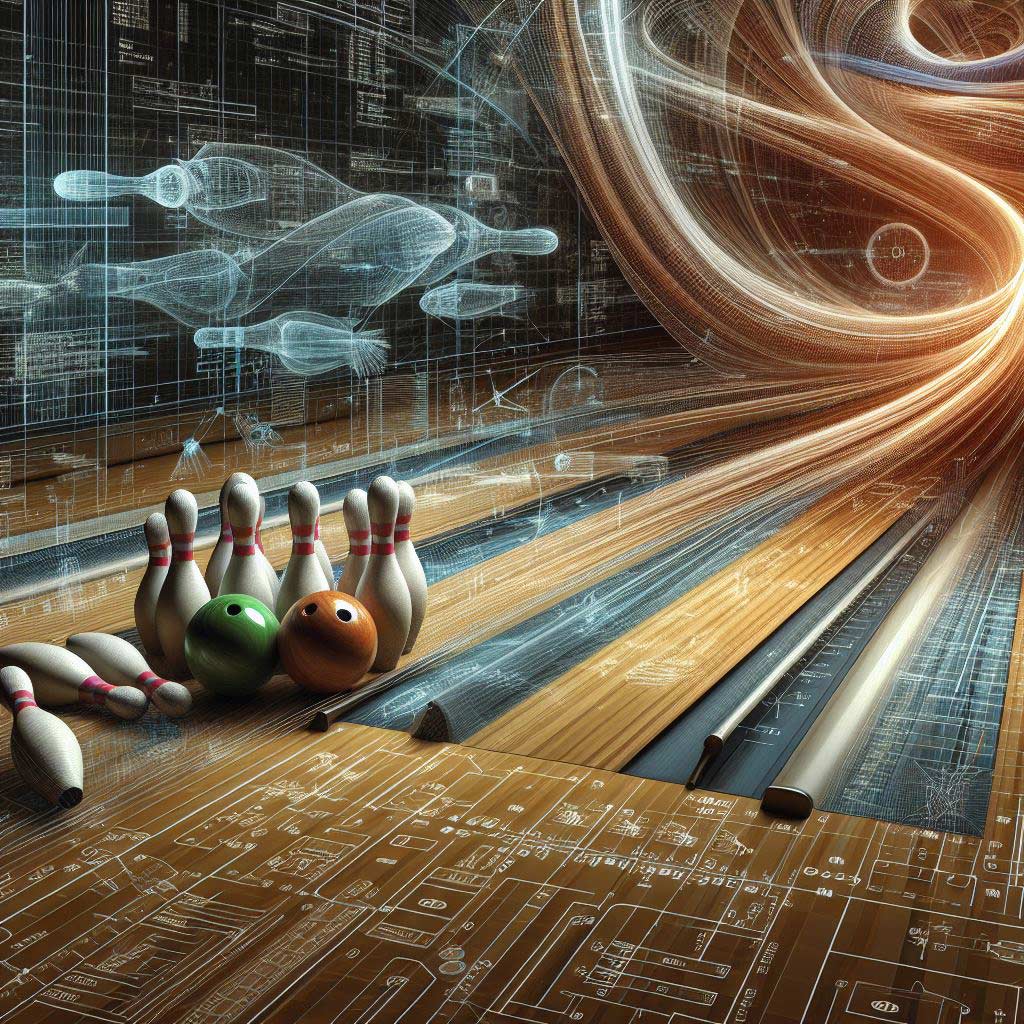Bowling is a beloved pastime enjoyed by over 70 million Americans each year. But have you ever stopped to think about the specialized surface you send those heavy balls hurtling down? At first glance, bowling lanes appear to be simple flat rectangular strips. Yet there is more below the surface than meets the eye.
As it turns out, regulation bowling lanes are not actually completely flat plains at all. They have an intentionally engineered subtle crown shape designed to influence ball motion and scoring.
In this article, we’ll dive into the facts around bowling lane shapes and surfaces. You may be surprised to discover bowling alleys have some carefully calculated hills and valleys!
The Surprising Crown Shape of Bowling Lanes
Many people reasonably assume bowling lanes are entirely flat and level. After all, they look flat from a standing height. However, bowling lanes actually have an engineered crown shape where the center of the lane angles downward slightly to the gutters on each side.
Specifically, regulation tenpin bowling lanes are built with a crowning height difference of 7 inches from the center arrows to each gutter. This equals about a 2.4-foot convex parabolic crown rise from gutter to gutter. So a 60-foot-long lane will have 0.4% slope or roughly 1/4 inch drop for every horizontal foot traveled laterally across.
This subtle crown is superficial in height but makes a major impact on ball motion, oil patterns, and scoring ability. It may only be a matter of inches, but those few inches are cleverly crafted to steer balls into the pocket.
Constructing the Crowned Foundation
The angled slope of bowling lanes is carefully constructed right from the initial building. The individual lane surface boards of maple wood or artificial laminates are fitted together to provide a slightly higher center point.
The width of lane surface boards ranges from about 4 inches up to 18 inches maximum. So only a few boards tilted at slight angles can create the sharpened foundation. The boards join lengthwise along the 60-foot direction of play.
By starting with an engineered crown base, the lanes then only need thin resurfacing periodically rather than full crown rebuilding. The initial build sets up the ideal foundation for ball control.
How Lane Oil Interacts with Lane Shape
Of course, seasoned bowlers know it’s not just the lanes carrying the ball towards strikes and spares. The lane condition oil patterns applied in strategic areas greatly influence ball hook and roll too. These oil distributions intentionally work with the crowned lane shape.
The oil patterns applied by lane machine extractors before play are carefully designed. More oil concentration and thickness go slightly left of the center boards. This is because the slope itself steers balls right from the higher center into the pocket zone. The oil gives a controllable slide before the big hook.
By pairing lane oil placements with the underlying slope, bowling alleys enable both controlled slides and angular pocket strikes. Without consideration of lane shape and oil together, bowlers would leave the gutter helpless!
The Purposeful Benefits of The Crown Design
At this point it should be clear bowling lanes contain intentional shaping structures beneath the wood and oil. While only inches in difference, the engineered crown serves critical ball control purposes:
- Prevents Hooking Too Early – A completely flat lane would allow for very early tight hook rolls. The ball would dive directly left or right of the thrower’s hand. But the center crown gently guides balls just enough to delay hooking. This allows proper slide length before angular entry into the pocket zone.
- Guides Balls Into Ideal Pocket Range – As discussed earlier, the subtle slope drop steers balls right towards the pocket segment. The 1/4 inch per foot slope translates the ball motion into reliable pocket entry angles. Without this calculated slant, many more shots would miss wide or fail to drive through the pins at ideal angles.
- Accommodates Varied Oil Patterns – The built-in directional slope provides foundational control no matter the oil volume or shape. Short oil, long oil, flat oil – the lane’s hidden shape still funnels balls properly rightwards. This gives bowling alleys creative leeway when designing oil patterns matching league styles and skill levels.
While the crown’s height difference is minimal, its impact pairing with customized oil patterns is undeniable. Next time you roll a powerful strike or frustrating 7-10 split, you can likely thank (or blame) the intentional slope foundations!
Wrapping Up the Truth About Bowling Lane Surfaces
Given most bowling centers aim to provide an ideal scoring pace, it makes sense that intentional engineering lives beneath the lanes. The regulation requirements for a subtle crown shape prove lanes aren’t actually flat. There is a method to the slight madness!
We hope this breakdown has helped shed light on the truth about bowling lane designs. Next time you visit the lanes for some strikes and laughs with friends, remember the hidden slope science that makes bowling such a precise sport. Those gutters may seem ever-eager to swallow errant throws, but smart foundational shaping is on your side too.
So embrace the next frame knowing the lanes themselves steer you towards strikes – as long as your release and timing stay tight. Let geometry and gravity do some work so you can focus on fun with friends!
Thanks for reading and be sure to subscribe using the form below for more insights into the physics and design behind beloved games and gear. May the pins keep falling in your favor!
Frequently Asked Questions
Why don’t bowling lanes dent?
Bowling lanes are made from hard maple wood, which is an extremely durable and resilient material that can withstand the impact of bowling balls. The wood is also coated in lacquer finishes and synthetic lane surfaces that protect the wood from damage. The construction is specifically engineered not to dent.
What is a flat in bowling?
In bowling, a flat refers to an oil pattern that doesn’t have a significant slope from side to side. On flat patterns, the oil is distributed more evenly from left to right with fewer breakpoint differences. This causes balls to hook later and more gradually.
Are some bowling lanes easier than others?
Yes, some bowling lanes can play easier or more difficult depending on factors like:
- Oil patterns – More oil volume and flatter patterns are generally more forgiving
- Wood quality/wear – Older wood can become saturated and absorb more oil
- Topography/crown height – Excessive slope alters ball reaction
How thick is bowling alley wood?
Bowling lane wood boards are typically 1 1/4 to 1 1/2 inches thick for regulation lanes. Synthetic overlay sheets tend to be slightly thinner at about 1 inch thick. This provides sufficient thickness to withstand ball impacts.
Why do bowling balls crack when not used?
Sitting unused over time, bowling balls absorb excess oil into the porous coverstock material. This causes swelling and densification that leads to cracking or checking. Using ball cleaners regularly prevents oil soaking even when not bowling frequently.
How do bowling lanes not get damaged?
Besides hardy maple construction, bowling centers regularly clean, resurface, and refinish lanes to keep them level and fill small dents/holes from forming. Daily lane oiling also helps condition wood, and foul light systems detect wayward throws before balls reach lanes.
What is 5 strikes in bowling called?
In ten pin bowling, five consecutive strikes is called a five-bagger. Some other bowling nicknames for multiple successive strikes in a row are the turkey (3) and the golden turkey (4).
Why are bowling alleys in basements?
Bowling alleys gained a reputation for basement locations originally because it was cheaper to build them underground at a time when bowling was taking off. However, modern lanes require climate control systems and most new centers avoid basement builds.
What is 4 strikes in a row called in bowling?
In bowling lingo, four consecutive strikes is referred to as a hambone. Four strikes in a row is considered a significant accomplishment and puts a bowler in good position for more.




